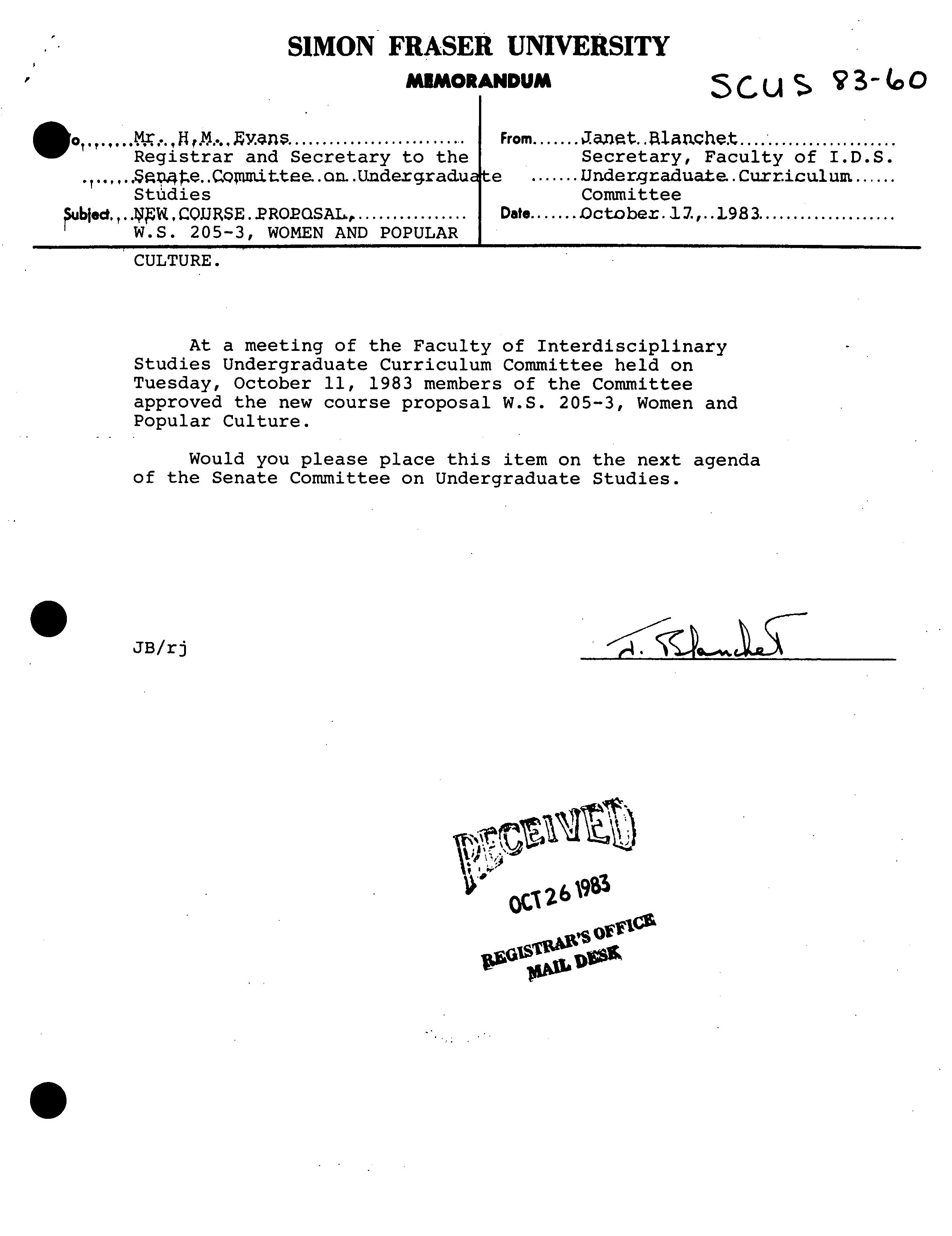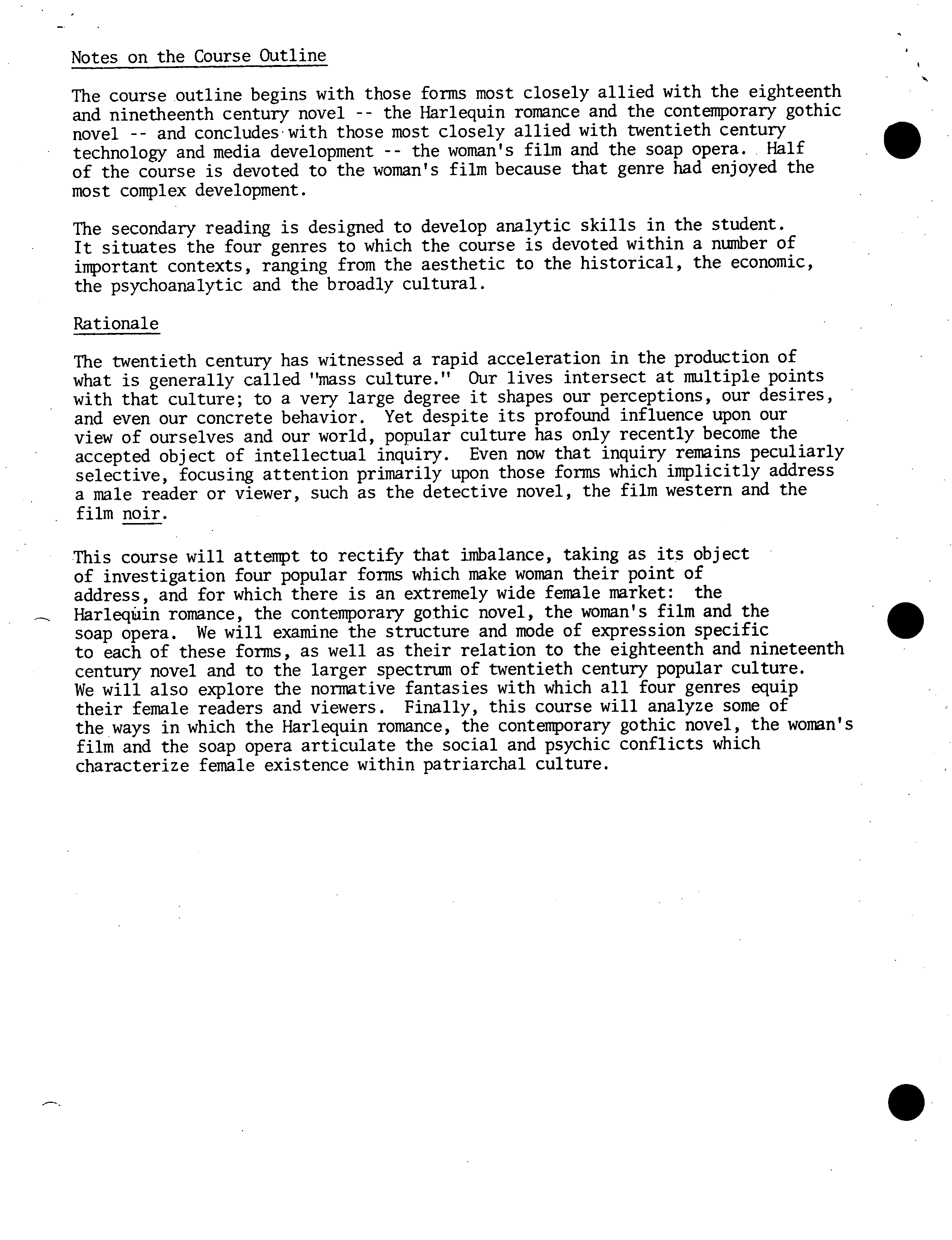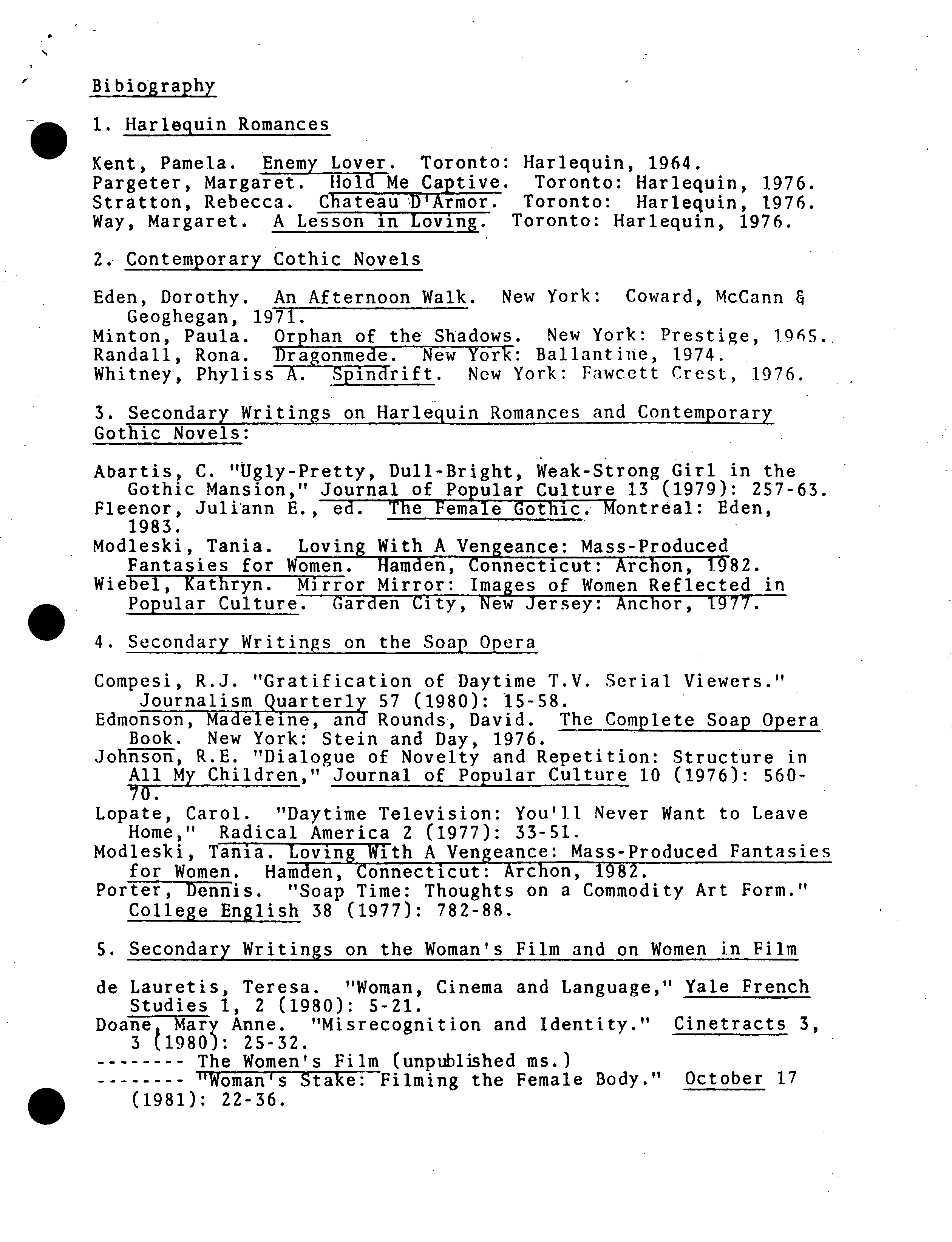SiMON FRASER UNIVERSITY
MEMORANDUM
00
.........................................................
SENATE COMMITTEE ON UNDERGRADUATE
From
.................STUTYIES.........................
CHANGES - WOMEN'S STUDIES. ?
Subect
....................................................
Date
....................................................
17 NOVEMBER 1983.
Action undertaken by the Senate Committee on Undergraduate
Studies at its meeting of November 15, 1983 gives rise to
the following motion:
MOTION: "That Senate approve and recommend approval
to the Board of Governors, as set forth in
S.83-95 , the proposed new course
W.S. 205-3 - Women and Popular Culture"
Subject to approval of the course by Senate and the Board of
S
Governors the Senate Committee on Undergraduate Studies approved
waiver of the normal two-semester time lag requirement to permit
first offering in Summer 84-2.
.
5(
,U
?3-(O
MEMORANDUM
SiMON FRASER UNIVERSITY
•o,.l!.,...M1;..
?
...........................
Registrar and Secretary to the
• .
S
J .e.
.C.owi'.tttee. . an.. Undergradu
Studies
ubjed,, .
.1Z , COJJRSE .
RO2QSAL ................
W.S. 205-3,
WOMEN AND POPULAR
CULTURE.
From.......
Janet..1che.t
........................
Secretary, Faculty of I.D.S.
Undergraduate. Curriculum ......
Committee
Date
.......Octhbe.r.1.,..1983....................
At a meeting of the Faculty of Interdisciplinary
Studies Undergraduate Curriculum Committee held on
Tuesday, October
11, 1983
members of the Committee
approved the new course proposal W.S.
205-3,
Women and
Popular Culture.
Would you please place this item on the next agenda
of the Senate Committee on Undergraduate Studies.
JB/rj
i
?
6 1963
SENATE COMMITTEE ON UNDERGRADUATE STUDIES
NEW COURSE PROPOSAL FOPJsI
1.
Calendar Information ?
Department: Women's Studies
Abbreviation Code: W.S.
?
Course Number: 205 Credit Hours: 3 Vector: 21-0
Title of Course:
Women and Popular Culture
Calendar Description of Course:
This course will examine some of the ways in which popular culture organizes female
perception and desire. It will focus upon four very successful genres of popular
culture, all of which pointedly address a female audience: the Harlequin romance,
the contemporary gothic novel, the women's film and the soap opera. We will
investigate the social and psychoanalytic ramifications of these four genres as
well as their structural and stylistic properties. Attention will also be given
to the interpretive process--to the activity of "reading"a popular novel, film
or television program.
Nature of course: Lecture/tutorial
Prerequisites (or special instructions): None
What course (courses), if any, is being dropped from the calendar if this course is
approved: None
2.
Scheduling
How frequently will the course be offered? Once a year
Semester in which the course will first be offered? Summer 1984
Which of your present faculty would be available to make the proposed offering
possible? ?
K. Silverman
Objectives of the Course
To provide an overview of the relation of women to popular culture, and a
detailed examination of four popular genres which appeal to a female audience.
See also the Calendar Description.
4. ?
Budgetary and Space Requirements (For information only)
What additional resources will be required in the following areas:
Faculty ?
None
Staff ?
None
Library
Audio Visual
?
Rental of four films.
Space ?
None
Equipment ?
Access to projector for six weeks, and video monitor for two weeks
5. ?
Approval
Date: ?
Oc?&
?
j183
Oe-
?
Departffent Chairman
?
Dean ?
Chairman, SCUS
S
SCUS 73-34b: (When completing this form, for instructions see Memorandum SCUS 73-34a.
Attach course outline).
Women's
Studies 205-3
WOMEN AND
POPULAR CULTURE
Week
Topic
..
Introduction
Suggested Reading/Viewing
2.
The Harlequin Romance
Pargeter, Hold Me Captive
Way, A Lesson In Lovg
Modleski, Loving With A Vengeance, Ch. 1
?
2
3.
The Harlequin Romance
Kent, Enemy Lover
Stratton, Chateau D'Anior
Wiebel
'
Mirror Mirror: Images of Women Reflected
in Popular Culture (excerpts)
4.
The Contemporary Gothic
Randall, Dragonmede
Novel
Eden, An Afternoon Walk
Modleski, Loving With A Vengeance, Ch.3.
S.
The Contemporary Gothic
Whitney, Spindrift
Novel
Minton, Orphan of the Shadows
?
- ?
- -
Russ, "Somebody is Trying to Kill Me"
Symonds, "Phobias After Marriage: Women's
Declaration of Independence"
6.
The Woman's Film: The
Cukor, Gaslight
Gothic Romance
Freud, "Psychoanalytic Notes Upon an Autobiographical
Account of a Case of Paranoia" and "Certain
•
Neurotic Mechanisms in Jealousy, Paranoia and
Homosexuality"
7.
The Woman's Film:
?
The
Hitchcock, Suspicion
Gothic Romance
Doane, The Woman's Film, Ch.7 (unpublished ms.)
8.
The Woman's Film:
?
The
Cukor, A Woman's Face
Medical Discourse
Mulvey, 'Visual Pleasure and Narrative Cinema"
Heath, "Difference"
9.
The Woman's Film:
?
The
Litvak, Snakepit
Medical Discourse
Doane, The Woman's Film, Ch.3 (unpublished ins.)
10.
The Woman's Film:
?
The
Vidor, Stella Dallas
Domestic Melodrama
Elsaesser, "Sound and Fury"
11.
The Woman's Film:
?
The
Sternberg, Blond Venus•
Domestic Melodrama
Jameson, "Reification and Utopia in Mass Culture"
12.
The Soap Opera
4 episodes from All My Children
Modleski, Loving With A Vengeance, Ch.4
13.
The Soap Opera
4 episodes from General Hospital
Lopate, "Daytime Television:
?
You'll Never Want to
Leave Home"
Porter, "Soap Time: Thoughts on a Commodity Art
Form'
Round, The Complete Soap Opera Book.
Notes on the Course Outline
The course outline begins with those forms most closely allied with the eighteenth
and ninetheenth century novel -- the Harlequin romance and the contemporary gothic
novel -- and concludes with those most closely allied with twentieth century
technology and media development -- the woman's film and the soap opera. Half
of the course is devoted to the woman's film because that genre had enjoyed the
most complex development.
The secondary reading is designed to develop analytic skills in the student.
It situates the four genres to which the course is devoted within a number of
important contexts, ranging from the aesthetic to the historical, the economic,
the psychoanalytic and the broadly cultural.
Rationale
The twentieth century has witnessed a rapid acceleration in the production of
what is generally called "mass culture." Our lives intersect at multiple points
with that culture; to a very large degree it shapes our perceptions, our desires,
and even our concrete behavior. Yet despite its profound influence upon our
view of ourselves and our world, popular culture has only recently become the
accepted object of intellectual inquiry. Even now that inquiry remains peculiarly
selective, focusing attention primarily upon those forms which implicitly address
a male reader or viewer, such as the detective novel, the film western and the
film noir.
This course will attempt to rectify that imbalance, taking as its object
of investigation four popular forms which make woman their point of
address, and for which there is an extremely wide female market: the
Harlequin romance, the contemporary gothic novel, the woman's film and the
soap opera. We will examine the structure and mode of expression specific
to each of these forms, as well as their relation to the eighteenth and nineteenth
century novel and to the larger spectrum of twentieth century popular culture.
We will also explore the normative fantasies with which all four genres equip
their female readers and viewers. Finally, this course will analyze some of
the ways in which the Harlequin romance, the contemporary gothic novel, the woman's
film and the soap opera articulate the social and psychic conflicts which
characterize female existence within patriarchal culture.
[1
de Lauretis, Teresa. "Woman, Cinema and Language," Yale French
Studies 1, 2 (1980): 5-21.
Doane, Mary Anne. "Misrecognition and Identity."
Cinetracts 3,
3 (1980): 25-32.
?
-
The Women's Film (unpublished ms.)
-
"Woman's Stake: Filming the Female Body." October 17
(1981): 22-36.
Bibiography
. 1. Harlequin Romances
Kent, Pamela. Enemy Lover. Toronto: Harlequin, 1964.
Pargeter, Margaret. hold Me Captive. Toronto: Harlequin, 1976.
Stratton, Rebecca. Chateau D'Armor. Toronto: Harlequin, 1976.
Way, Margaret. A Lesson in Loving. Toronto: Harlequin, 1976.
2.
Contemporary Cothic Novels
Eden, Dorothy. An Afternoon Walk. New York: Coward, McCann
Geoghegan, 1971.
Minton, Paula. Orphan of the Shadows. New York: Prestige, 1.965..
Randall, Rona. Dragonmede. New York: Ballantine, 1974.
Whitney, Phyliss A. Spindrift. New York: Fawcett Crest, 1976.
3.
Secondary Writings on Harlequin Romances and Contemporary
Gothic Novels:
Abartis, C. "Ugly-Pretty, Dull-Bright, Weak-Strong Girl in the
Gothic Mansion," Journal of Popular Culture 13 (1979): 257-63.
Fleenor, Juliann E., ed. The Female Gothic. Montreal: Eden,
1983.
Modleski, Tania. Loving With A Vengeance: Mass-Produced
Fantasies for Women. Hamden, Connecticut: Archon, 1.982.?
Wiebel, Kathryn. Mirror Mirror: Images of Women Reflected in
• .
?
Popular Culture. Garden City, New Jersey: Anchor, 1977.
4. Secondary Writings on the Soap Opera
Compesi, R.J. "Gratification of Daytime T.V. Serial Viewers."
Journalism Quarterly 57 (1980): 15-58.
Edmonson, Madeleine, and Rounds, David. The Complete Soap Opera
Book. New York: Stein and Day, 1976.
Johnson, R.E. "Dialogue of Novelty and Repetition: Structure in
All My Children," Journal of Popular Culture 10 (1976): 560-
70.
Lopate, Carol. "Daytime Television: You'll Never Want to Leave
Home," Radical America 2 (1977): 33-51.
Modleski, Tania. Loving With A Vengeance: Mass-Produced Fantasies
for Women. Hamden, Connecticut: Archon, 1982.
Porter, Dennis. "Soap Time: Thoughts on a Commodity Art Form."
College English 38 (1977): 782-88.
S. Secondary Writings on the Woman's Film and on Women in Film
Patricia Mellencamp and Linda Williams, eds. Feminist
Re-Visions. ?
Los Angeles: AF1. 1.983.
Flitterman, Sandy. "Woman, Desire and the Look: Feminism and the
Enuciative Apparatus in Cinema, Cine-Tracts 2, 1 (1978): 63-
68.
Haskell, Molly. From Reverence to Rare: The Treatment of Women
in the Movies. New York: Holt, Rinehart and Winston, 1973.
Heath, Stephen. "Difference." Screen 19, 3 (1978): 50-112.
Kuhn, Annette. Pictures of Women. London: Routledge
?
Kegan
Paul, 1982.
Williams, Linda. "Film Body: An Implantation of Perversions,"
Cine-Tracts 3, 4 (1981): 19-35.
6. General Theory and Background Reading
Elsaesser, Thomas. "Tales of Sound and Fury: observations on the
Family Melodrama," Monogram 4 (1973):
.
(1972): 2-15.
Freud, Sigmund. On Creativity and the Uf.conscious, ed. Benjamin
Nelson. New York: Harper, 1958.
Sexuality and the Psychblogy of Love, ed. Philip
Rieff. New York: Macmillan, 1968.
Three Case Histories, ed. Philip Rie.ff. New
York: Collier, 1973.
Horton, S.R. "Desire and Depression in Women's Fiction: The
Problematic and Economics of Desire." Modern Fiction Studies
24 (1978): 181-195.
Jameson, Fredric. "Reification and Utopia in Mass Culture."
Social Text 1 (1979): 130-48.
Regan, N. "Home of One's Own: Women's Bodies in Recent Women's
Fiction." Journal of Popular Culture 11. (1.978): 772-8.8.
Symonds, Alexandra. "Phobias After Marriage: Women's Declaration
of Dependence." In Psychoanalysis and Women. eds. Jean Baker
Miller. New York: Penguin, 1978.
Watt, Ian. The Rise of the Novel: Studies in Defoe, Richardson?
and Fielding. Berkeley: Universit
— y -- o
-
T California, 1957.
0







